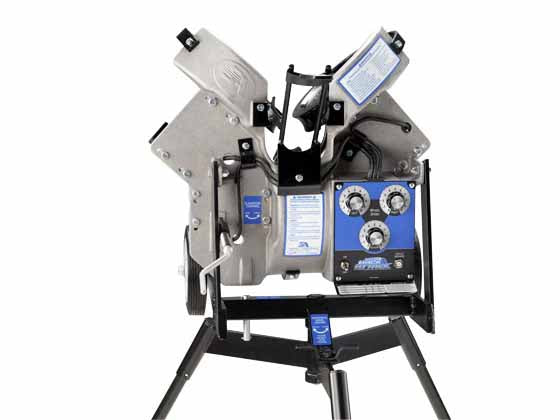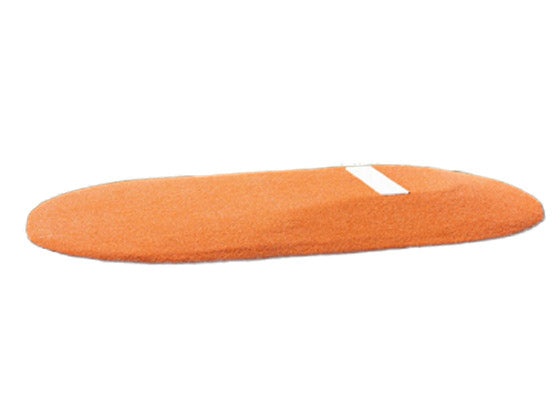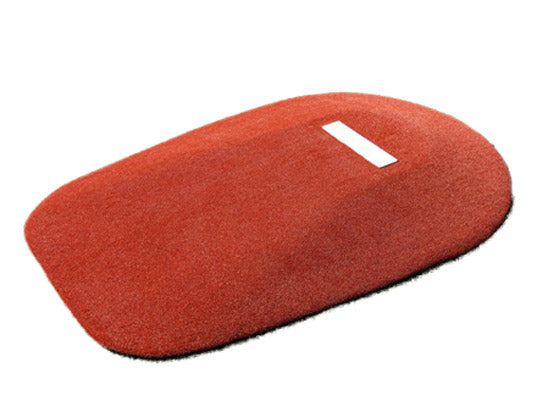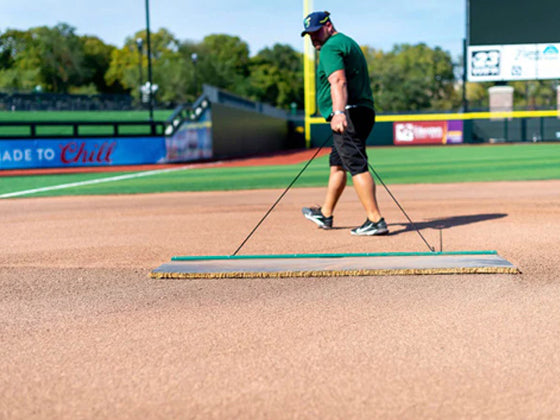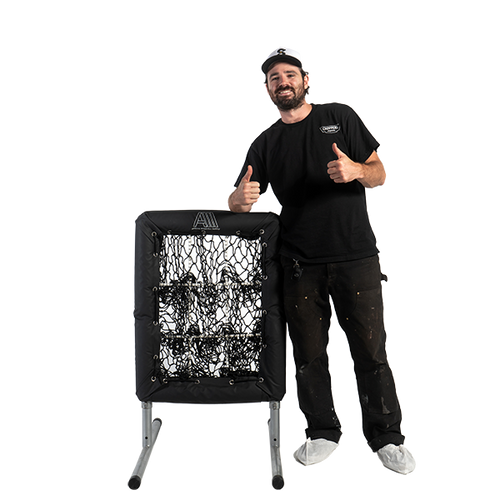Let's face it—nothing beats the feeling of watching your young pitcher confidently toe the rubber, eyes locked with the catcher, and deliver a perfect strike. But here's the truth bomb: that confidence doesn't just happen. It's built through consistent practice on quality equipment that feels like the real deal.
I've spent years working with youth baseball programs, and I can tell you firsthand—the right pitching mound makes all the difference between a kid who dreads pitching practice and one who can't wait to get out there and throw.
Quick take: If you're short on time, my top recommendation for youth baseball is the ProMounds Major League Game Mound with turf surface. It's tournament-ready, gives young pitchers that authentic feel, and will last you through multiple seasons of heavy use. (But stick around because depending on your young pitcher's age and goals, one of the other options might be even better for you.)
Why Turf Mounds Are Game-Changers for Youth Pitchers
When I started coaching 12U baseball, we practiced on whatever surface we could find—bumpy fields, parking lots, even my backyard. The inconsistency was killing our pitchers' development. Then we invested in a quality turf mound, and I watched our pitchers' confidence transform in just weeks.
Turf portable pitching mounds offer three major advantages that make them worth every penny:
-
Realistic feel without the maintenance - You get that game-day mound experience without having to rake, tamp, and water clay (and trust me, no youth coach needs more tasks on their plate).
-
Season-extending durability - These mounds hold up in conditions that would turn dirt mounds into mud pits. One of my teams used theirs for spring practice when the fields were still too wet to use.
-
Consistent landing zone - That turf landing area gives pitchers a reliable surface for their stride foot, which is absolutely crucial for developing proper mechanics and preventing injuries.
One coach I worked with in California told me his team's ERA dropped by nearly two runs after a month of practicing on their new turf mound. The consistency was allowing his pitchers to focus on execution rather than compensating for unpredictable footing.
Top Turf Portable Pitching Mounds for Different Youth Levels
Let's break down which mounds work best for different ages and skill levels. I've personally tested or coached on all of these, so these aren't just specs on a page—these are real-world experiences.
For 7-10 Year Olds: Perfect For Developing Proper Mechanics
At this age, pitchers are just learning the fundamentals, and you need equipment that helps them develop good habits from the start.
The Pitch Pro 3" Portable Turf Mound
This thing is fantastic for the younger crowd. At just 3" high with a gradual slope, it's perfect for kids still developing their coordination. The turf surface is forgiving on growing arms but still gives enough "grab" for proper push-off.
What makes this mound special is how it builds confidence. One of my players—a shy 8-year-old who used to get visibly nervous before pitching—started requesting extra practice time once we got this mound. The stable surface remove his fear of slipping, and he could focus purely on his delivery.
Specs at a glance:
- 3" height (perfect for 46' distances)
- Weather-resistant turf surface
- Weighs under 35 lbs (easy for a single coach to move)
- Regulation of rubber spacing
I watched a young pitcher go from throwing maybe 50% strikes to consistently hitting 70%+ in just three weeks of practice on this mound. And yeah, those stitches in the catcher's mitt sound pretty sweet when they're hitting the target consistently.
For 11-13 Year Olds: The Transition Phase
This is where things get interesting. Players this age are often transitioning to bigger fields, and their mechanics are becoming more sophisticated.
Field Saver 6" Portable Game Mound with Premium Turf
This is the sweet spot for serious 12U teams. The 6" height is regulation for 50-60' pitching distances, and the landing area is substantial enough for growing kids still figuring out their stride length.
I grabbed one of these on a whim last season for our travel team—didn't expect it'd become my MVP piece of equipment. The turf quality makes a real difference here; it's dense enough to simulate real field conditions but won't tear up cleats like some cheaper options.
Specs that matter:
- 6" regulation height
- Premium-grade artificial turf
- 101 lbs (solid stability, still portable with two people)
- Fiberglass construction that stands up to weather
During a particularly wet spring in Ohio, our team kept its development on track by using this mound in an indoor facility while other teams lost weeks of practice time. By the first tournament, our pitchers were already in mid-season form.
For 14+ Travel Ball and High School Prep
Now we're talking serious baseball. These players need equipment that perfectly replicates game conditions.
True Pitch 10" Game Mound with Pro-Grade Turf Surface
When your pitcher is eyeing high school play or showcases, this is your move. The 10" height is regulation for 60'6" distances, and the professional-grade turf is identical to what's used in many college facilities.
What separates this from lesser mounds:
- 10" regulation height for 60'6" pitching distance
- Pro-grade artificial turf with proper give and traction
- Reinforced landing area that won't break down
- 185 lbs of stability (this thing doesn't budge)
Last summer, I worked with a high school freshman who had incredible raw talent but inconsistent mechanics. After six weeks of training on a True Pitch, his velocity jumped 4 mph and his walk rate cut in half. The mound's stability allowed him to really drive downhill and develop a consistent release point.
To maximize your mound investment, don’t forget the little extras. Our article on accessories for portable pitching mounds covers must-have items that protect your gear and enhance each practice session.
Real Talk: What To Look For In A Youth Turf Mound
After seeing dozens of different mounds in action, here's what separates the game-changers from the dust-collectors:
1. Turf Quality Is Non-Negotiable
The difference between cheap turf and quality turf is night and day. Look for:
- Dense fiber construction that won't flatten out
- A natural amount of "give" that mimics real grass
- UV-resistant materials that won't fade or degrade
I once saw a team try to save money on a budget mound, and the turf wore bald spots within a month. Their pitchers were basically throwing on plywood by mid-season.
2. Stability vs. Portability: Find Your Balance
A 200-pound mound gives amazing stability but might be impractical if you're moving it frequently. Consider:
- How often you'll transport it
- Available storage space
- Whether you have help for moving it
For my middle school team that practices at multiple locations, we chose a slightly lighter model with built-in handles. For my high school pitchers who train in one location, we went heavier for maximum stability.
3. Height Matters More Than You Think
Using the wrong height can actually develop bad habits:
- Too low: Pitchers won't learn proper downhill mechanics
- Too high: Young arms might develop strain, compensating for the height
One 12-year-old pitcher I worked with developed arm soreness after practicing on a 10" mound his dad bought (thinking bigger was better). We switched to a proper 6" mound, and his pain disappeared while his control improved.
Beyond The Mound: Maximizing Your Investment
Once you've got your perfect turf mound, here's how the best coaches and players get the most from it:
Practice Drills That Really Work
The beauty of a portable mound is being able to incorporate it into comprehensive practice plans:
-
The 21-Pitch Challenge: Have pitchers throw 7 pitches to 3 different locations, scoring points for accuracy. This builds command while creating healthy competition.
-
Towel Drill Station: Place the mound near a fence, have pitchers perform towel drills to perfect their mechanics before throwing actual pitches.
-
Video Analysis Setup: The consistent surface makes a portable mound perfect for recording and analyzing mechanics from the same angle every time.
I've seen young pitchers make more progress in three focused 20-minute sessions on a quality mound than in weeks of unstructured practice.
Want a full routine to structure your training sessions? Check out our guide on training routines with a portable pitching mound to help young pitchers build consistency and confidence.
My Personal Take: Which One Would I Buy?
If I were starting from scratch with a youth team today, I'd invest in the Field Saver 6" model for a 12U team. It hits the sweet spot of quality, appropriate height, and durability without breaking the bank.
For my son's personal use at home? The Pitch Pro 3" is perfect for a developing young arm and easy enough to move around our yard.
But here's the thing—any quality turf mound beats practicing on inconsistent surfaces. I've watched too many promising young pitchers develop bad habits trying to compensate for poor footing.
Final Pitch: It's About Development, Not Just Games
A quality turf pitching mound isn't just a piece of equipment—it's an investment in player development and confidence. Young pitchers who train on proper surfaces develop cleaner mechanics, better control, and most importantly, a love for pitching that comes from seeing consistent improvement.
I grabbed one on a whim—didn't expect it'd become my MVP piece of equipment. But watching our pitchers develop clean, repeatable mechanics while staying healthy made it clear this was the best baseball investment we made all year.
Ready to up your young pitcher's game? Trust me, the right mound changes everything.

 Contact Us
Contact Us